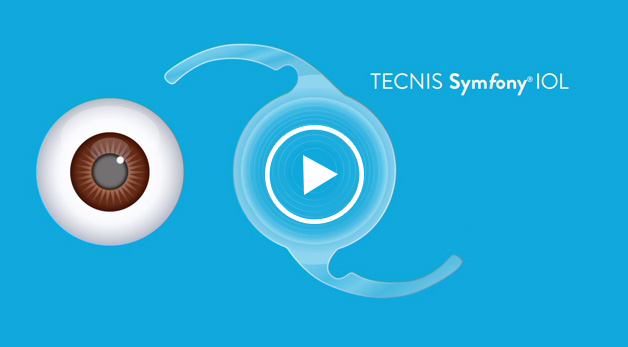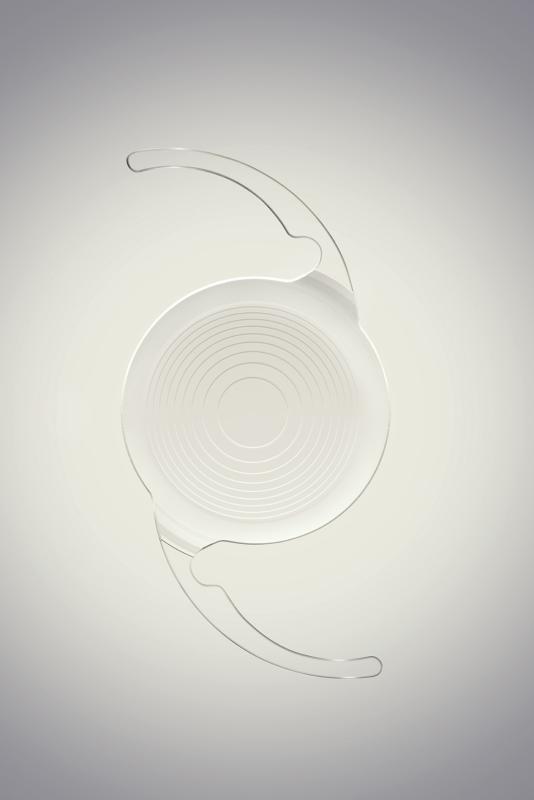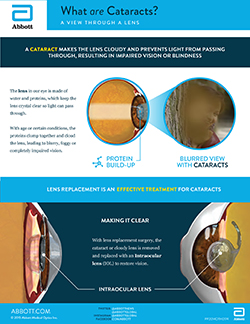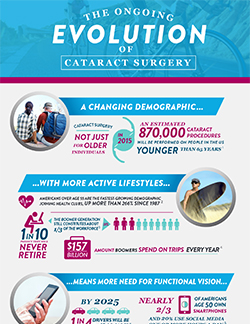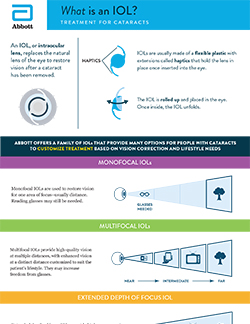Best Cataract Surgery Choices:
New Implant for Cataract Surgery
It remains the best time in history to have a cataract. Cataracts are no longer the leading cause of blindness in developed areas, though it remains so in developing countries. A new intraocular lens was just approved in the US by the FDA and it has promise to improves the reading, distance, AND computer vision and total visual outcomes of all our patients.
I am not sponsored by any drug company, so below are the pros and cons of each available lens. As of September 2016, I would choose the Catalys Femtosecond Laser AND the Symfony lens for myself or any of my family members.
Sandra Lora Cremers, MD, FACS
Tecnis Symfony®
FDA Approves the Tecnis Symfony® Intraocular Lenses, the First and Only Extended Depth of Focus Lenses for People with Cataracts
- Approval includes Toric version of Symfony IOL for people with astigmatism
- Lenses provide high-quality continuous vision so patients can see
clearly at near, intermediate and far-away distances, and points in
between, while wearing glasses less
clearly at near, intermediate and far-away distances, and points in
between, while wearing glasses less
PR Newswire, ABBOTT PARK, Ill., July 15, 2016
Abbott announced today that the U.S. Food and Drug Administration (FDA) has approved the Tecnis Symfony®
Intraocular Lenses for the treatment of cataracts. The first in a new
category of intraocular lenses (IOLs), the Tecnis Symfony lenses are the
only lenses in the United States that provide a full range of
continuous high-quality vision following cataract surgery, while also
mitigating the effects of presbyopia by helping people focus on near
objects. The FDA approval includes a version of the lens for people with
astigmatism, the Tecnis Symfony Toric IOL.
Cataracts are a common condition, with almost 4 million cataract
surgeries performed each year, and that number is expected to increase.1 By age 80, more than half of all Americans either have a cataract or have had cataract surgery.2
However, cataracts do not just impact seniors. In 2016 it is estimated
that nearly one in four cataract surgeries will be performed on people
younger than 65.1 Many people who have cataracts experience
other problems with their vision, such as presbyopia and astigmatism,
which the Symfony lenses also address. Presbyopia, which affects most
people over age 40, means people have lost the ability to focus on
objects up close and often require glasses to perform near visual tasks.
Astigmatism is when the cornea is misshapen, which causes blurry or
distorted vision.
“The Symfony intraocular lens is a new option I can offer my patients
to improve their vision following cataract surgery, especially those
who have difficulty focusing on objects at near distances because of
presbyopia,” said Eric D. Donnenfeld, M.D., of Ophthalmic Consultants of
Long Island, New York. “Many of my patients live very active lifestyles
and want to see clearly at all distances, and without glasses if
possible. With the Symfony lens, I can give patients the freedom to
enjoy the activities that matter to them, while wearing glasses less.”
During cataract surgery, the natural lens of the eye is removed, and
an artificial lens, called an intraocular lens, or IOL, is inserted into
the eye. The IOL most commonly used in cataract surgery is a monofocal
lens, which only allows the person to see at a distance, with closer
objects being out of focus. In contrast, the Symfony lens was
specifically developed with features to improve both the range and
quality of vision.
“Abbott is focused on improving people’s vision and their lives by
helping them stay healthy and active. Symfony offers patients, including
those with astigmatism, an option for crisp, clear vision at all
distances,” said Thomas Frinzi, senior vice president of Abbott’s vision
business. “This is an important addition to our portfolio of lenses, as
we expect many patients to choose a Symfony lens over a standard
monofocal lens, given its benefits. We are happy that we can offer more
people around the world this new category of lenses.”
The approval was based on results of a U.S. pivotal study that
compared the Tecnis Symfony lens to a Tecnis aspheric monofocal lens in
298 patients. Compared with patients in the monofocal group, those who
received a Tecnis Symfony IOL achieved greater improvements in
intermediate and near vision while maintaining similar distance vision.
Patients in the Symfony group were also more likely to achieve reduced
overall spectacle wear and high overall visual performance in any
lighting condition. Rates of adverse events did not differ between the
Symfony and monofocal groups.
The Symfony lens is approved in more than 50 countries around the
world, and has been widely studied, with data from numerous clinical
studies involving over 2,000 eyes. In clinical studies, the Symfony
lens:
- Provided seamless, day-to-night vision. Patients could see objects sharply and clearly at near, intermediate and far away distances, and points in between.
-
Provided high-quality vision. Some IOLs may leave
patients with an inability to focus clearly due to competing wavelengths
of light passing through the lens at different angles (known as
chromatic aberration), or with vision that is not completely focused
because of the shape of the lens (known as spherical aberration). The
Symfony lens has been engineered to correct these issues. -
Demonstrated a low incidence of halo and glare, which
may be perceived as rings or blurring around bright lights. Glare and
halo can sometimes affect an individual’s ability to drive at night or
to perform other visual tasks.
INDICATIONS AND IMPORTANT SAFETY INFORMATION FOR TECNIS SYMFONY AND TECNIS SYMFONY TORIC EXTENDED RANGE OF VISION IOLs
CAUTION: Federal law restricts this device to sale by or on the order of a physician.
INDICATIONS FOR USE: The TECNIS Symfony IOL, Model
ZXR00, is indicated for primary implantation for the visual correction
of aphakia in adult patients with less than 1 diopter of pre-existing
corneal astigmatism in whom a cataractous lens has been removed. The
lens mitigates the effects of presbyopia by providing an extended depth
of focus. Compared to an aspheric monofocal IOL, the lens provides
improved intermediate and near visual acuity while maintaining
comparable distance visual acuity. The Model ZXR00 IOL is intended for
capsular bag placement only.
The TECNIS Symfony Toric IOLs, Models ZXT150, ZXT225, ZXT300 and
ZXT375, are indicated for primary implantation for the visual correction
of aphakia and for reduction of residual refractive astigmatism in
adult patients with greater than or equal to 1 diopter of preoperative
corneal astigmatism in whom a cataractous lens has been removed. The
lens mitigates the effects of presbyopia by providing an extended depth
of focus. Compared to an aspheric monofocal IOL, the lens provides
improved intermediate and near visual acuity while maintaining
comparable distance visual acuity. The Model Series ZXT IOLs are
intended for capsular bag placement only.
CONTRAINDICATIONS: None.
RISKS: Routine cataract surgery risks, irrelevant to
lens selection, could be minor, temporary, or affect patients’ vision
permanently. Rare complications are worsening of vision, bleeding, or
infection. Risks related to use of this lens include a slight loss in
vision sharpness with decreased use of glasses. Even with glasses, loss
of sharpness may worsen under poor visibility conditions such as dim
light or fog. This may lead to driving difficulties, and not detecting
road hazards as quickly at night or in fog. Patients may also notice
halos, starbursts, glare, and other visual symptoms with extended range
of vision IOLs. This may impact patients when there are bright lights at
night. Patients should discuss all risks and benefits with their eye
doctor before surgery.
WARNINGS: A small number of patients may want their
TECNIS Symfony IOL removed because of lens-related optical/visual
symptoms. Patients with pre-existing diseases or conditions (i.e.,
diabetes and heart disease) may have higher risk of experiencing
complications (e.g., more difficult recovery) after routine cataract
surgery. Patients should not receive this lens if they have had previous
trauma to their eye. Not evaluated for use in children.
PRECAUTIONS: If the patient’s eye is unhealthy
(including glaucoma), vision may not be good even after cataract
removal; patients may not get full benefit of the TECNIS IOL. Before
surgery, the eye doctor will check for any eye diseases. Patients’
vision with the TECNIS Symfony IOL may not be good enough to perform
detailed ‘up-close’ work without glasses, and rarely, may make some
types of retinal treatment (e.g., retinal tear repair) more difficult.
Patients should take all prescribed medicines and apply eye drops as
instructed to avoid inflammation and infection. Patients should avoid
bending down and playing sports, which can harm the eye during recovery.
The eye doctor will tell patients what activities to avoid.
SERIOUS ADVERSE EVENTS: Serious adverse events observed
during the TECNIS Symfony clinical trial were not related to the
lenses. These events included swelling of the retina, inflammation and
secondary surgeries.




